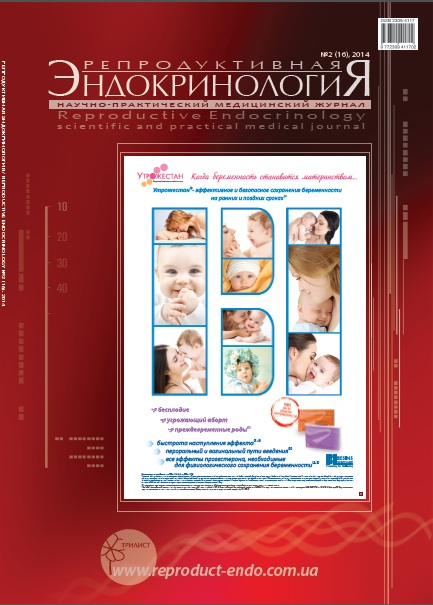Triple-marker prenatal screening program for chromosomal defects
DOI:
https://doi.org/10.18370/2309-4117.2014.16.84-90Keywords:
chromosomal abnormalities, Down syndrome, prenatal screening, triple marker screeningAbstract
To examine screening performance of California’s triple-marker screening program, using data from a statewide registry for chromosomal defects.
This study included 752,686 women who received a screening risk and had an expected date of delivery between July 2005 and the end of June 2007. Follow-up diagnostic services for screen-positive women were performed at state-approved centers. Data on diagnostic outcomes from these visits were entered into the California Chromosomal Defect Registry (CCDR). Other CCDR sources include mandatory reporting by all cytogenetic laboratories and hospitals and outcome data forms submitted by prenatal care providers.
The observed detection rate for Down syndrome (n = 1,217) was 77,4%. It varied significantly by gestational dating method and maternal age. The rates for women aged younger than 35 years and 35 years and older were 62,4% and 94.0%, respectively. The detection rates were 81,3% for ultrasound-dated pregnancies and 67,5% for last menstrual period–dated pregnancies. For Turner syndrome, trisomy 18, triploidy, and trisomy 13, the detection rates were 79,4%, 82,5%, 98,1%, and 36,0%, respectively. The positive rate for Down syndrome was 5,4%. Of women with a Down syndrome fetus who were screen positive, only 49,5% opted for amniocentesis. Of women who obtained results from amniocentesis indicating a Down syndrome fetus, 61,4% had an elective termination, 26,2% had a live birth, 4,5% had a death or miscarriage, and 7,9% had an unknown outcome.
The observed performance of this large triple-marker screening program exceeds generally predicted detection rates for Down syndrome. This study methodology will be used to measure the performance of subsequent screening enhancements.
References
- Cunningham, G.C. Tompkinison, D.G. «Cost and effectiveness of the California triple marker prenatal screening program.» Genet Med, 1(1999):199-206.
- California Code of Regulations, Title 17, Section 6532. Current as of January 09, 2009. Available at: http://ccr.oal.ca.gov/linkedslice/default.asp?SP_CCR- 1000&Action_Welcome. Retrieved January 09, (2009).
- Wald, N.J. Cuckle, H.S. Densem, J.W. Nanchahal, K. Royston, P. Chard, T. et al. «Maternal serum screening for Down’s syndrome in early pregnancy.» [published erratum appears in BMJ 1988;297:1029]. BMJ, 297(1988):883-7.
- Palomaki, G.E. Haddow, J.E. Knight, G.J. Wald, N.J. Kennard, A. Canick, J.A. et al. «Risk-based prenatal screening for trisomy 18 using alpha-fetoprotein, unconjugated oestriol and human chorionic gonadotropin.» Prenat Diagn, 15(1995):713-23.
- Morris, J.K. Mutton, D.E. Alberman, E. «Revised estimates of the maternal age specific live birth prevalence of Down’s syndrome.» J Med Screen, 9(2002):2–6.
- Morris, J.K. Wald, N.J. Watt, H.C. «Fetal loss in Down syndrome pregnancies.» Prenat Diagn, 19(1999):142-5.
- Palomaki, G.E. Bradley, L.A. McDowell, G.A. «Down syndrome working group, ACMG Laboratory Quality Assurance Committee. Technical standards and guidelines: prenatal screening for Down syndrome.» Genet Med, 7(2005):344-54.
- SAS Institute, Inc. SAS software of statistical analysis. Version 9.1.3. Cary (NC): SAS Institute, Inc.; 2005.
- National Center for Health Statistics. 2006 birth tables. National Vital Statistics System. Hyattsville, MD: US Department of Health and Human Services, CDC, National Center for Health Statistics. Available at: http://205.207.175.93/VitalStats/ TableViewer/tableView.aspx?ReportId_15095.
- ACOG educational bulletin. Maternal serum screening. Number 228, September 1996 (replaces no. 154, April 1991). Committee on Educational Bulletins of the American College of Obstetricians and Gynecologists. Int J Gynaecol Obstet 1996;55:299–308.
- Wald, N.J. Kennard, A. Hackshaw, A. McGuire, A. «Antenatal screening for Down’s syndrome [published erratum appears in J Med Screen 1998;5:110. J Med Screen 1998;5:166].» J Med Screen, 4(1997):181-246.
- Wald, N.J. Rodeck, C. Hackshaw, A.K. Walters, J. Chitty, L. Mackinson, A.M. «First and second trimester antenatal screening for Down’s syndrome: the results of the Serum, Urine and Ultrasound Screening Study (SURUSS).» J Med Screen, 10(2003):56-104.
- Bray, I.C. Wright, D.E. «Estimating the spontaneous loss of Down syndrome fetuses between the times of chorionic villus sampling, amniocentesis and livebirth.» Prenat Diagn, 18(1998): 1045-54.
- Cuckle, H. «Down syndrome fetal loss rate in early pregnancy.» Prenat Diagn, 19(1999):1177-9.
- Halliday, J.L. Watson, L.F. Lumley, J. Danks, D.M. Sheffield, L.J. «New estimates of Down syndrome risks at chorionic villus sampling, amniocentesis, and livebirth in women of advanced maternal age from a uniquely defined population.» Prenat Diagn, 15(1995):455-65.
- Malone, F.D. Canick, J.A. Ball, R.H. Nyberg, D.A. Comstock, C.H. Bukowski, R. et al. «First-trimester or second-trimester screening, or both, for Down’s syndrome.» N Engl J Med, 353(2005): 2001-11.
- Wapner, R. Thom, E. Simpson, J.L. Pergament, E. Silver, R. Filkins, K. et al. «First-trimester screening for trisomies 21 and 18.» N Engl J Med, 349(2003): 1405-13.
- Nicolaides, K.H. Spencer, K. Avgidou, K. Faiola, S. Falcon, O. «Multicenter study of first-trimester screening for trisomy 21 in 75 821 pregnancies: results and estimation of the potential impact of individual risk-orientated two-stage first-trimester screening.» Ultrasound Obstet Gynecol, 25(2005):221-6.
- Breathnach, F.M. Malone, F.D. Lambert-Messerlian, G. Cuckle, H.S. Porter, T.F. Nyberg, D.A. «First- and second trimester screening: detection of aneuploidies other than Down syndrome.» Obstet Gynecol, 110(2007):651-7. 20. ACOG Committee on Practice Bulletins. ACOG Practice Bulletin No. 77: screening for fetal chromosomal abnormalities. Obstet Gynecol, 109(2007):217-27.
Downloads
Published
How to Cite
Issue
Section
License
Copyright (c) 2014 N. Neely Kazerouni, Bob Currier, Linda Malm, Susan Riggle, Christina Hodgkinson, Sylvia Smith, Corinna Tempelis, Fred Lorey, Amber Davis, Laura Jelliffe-Pawlowski, Lynn Walton-Haynes, Marie Roberson

This work is licensed under a Creative Commons Attribution 4.0 International License.
Authors who publish with this journal agree to the following terms:
- Authors retain copyright and grant the journal right of first publication with the work simultaneously licensed under a Creative Commons Attribution License that allows others to share the work with an acknowledgement of the work's authorship and initial publication in this journal.
- Authors are able to enter into separate, additional contractual arrangements for the non-exclusive distribution of the journal's published version of the work (e.g., post it to an institutional repository or publish it in a book), with an acknowledgement of its initial publication in this journal.







